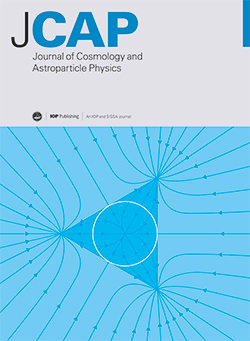黑洞烟花的时空手术
IF 5.9
2区 物理与天体物理
Q1 ASTRONOMY & ASTROPHYSICS
Journal of Cosmology and Astroparticle Physics
Pub Date : 2025-01-23
DOI:10.1088/1475-7516/2025/01/098
引用次数: 0
摘要
我们使用剪切粘贴技术为黑洞到白洞的转变(称为黑洞烟花场景)构建了一个显式模型。在环量子引力激励度规的背景下,我们利用类时壳的演化来模拟黑洞坍缩,然后利用类空壳分析来构造烟花几何。我们简单而明确的分析消除了以前文献中存在的一些微妙问题[1],并使连接点条件的检查更容易。我们进一步指出,在我们的和参考文献[1]的原始情景中,落体和渐近的观察者遇到了完全不同的物理现象。对于落入的观测者来说,弹跳的适当时间可以毫无歧义地确定,而对于渐近观测者来说,弹跳的时间间隔可以通过改变在事件视界外剪切和粘贴时空的方式来任意选择。令人困惑的是,一个遥远的(而不是坠落的)观察者的固有时间受制于随机性,因为坠落的观察者应该经历更强的量子引力效应。这一结果可能表明,黑洞烟花场景不允许视界内存在有效的经典时空。因此,主要的信息是,即使我们严格遵循薄壳形式来剪切和粘贴时空,这也不能保证所得到的时空提供一个物理上合理的背景。本文章由计算机程序翻译,如有差异,请以英文原文为准。
Spacetime surgery for black hole fireworks
We construct an explicit model for the black hole to white hole transition (known as the black hole fireworks scenario) using the cut-and-paste technique. We model a black hole collapse using the evolution of a time-like shell in the background of the loop quantum gravity inspired metric and then the space-like shell analysis to construct the firework geometry. Our simple and well-defined analysis removes some subtle issues that were present in the previous literature [1] and makes the examination of the junction conditions easier. We further point out that the infalling and asymptotic observers, both in ours and the original scenario in ref. [1], encounter quite different physics. While the proper time of the bounce for an infalling observer can be determined without ambiguity, the bouncing time interval for the asymptotic observer can be chosen arbitrarily by changing how one cuts and pastes the spacetimes outside the event horizons. It is puzzling that the proper time of a distant (rather than infalling) observer is subject to randomness since the infalling observer is supposed to experience a stronger quantum gravity effect. This result might suggest that a black hole firework scenario does not allow for the existence of an effectively classical spacetime inside the horizon. The main message is therefore that even if we strictly follow the thin shell formalism to cut and paste spacetimes, this does not guarantee that the resulting spacetime offers a physically reasonable background.
求助全文
通过发布文献求助,成功后即可免费获取论文全文。
去求助
来源期刊

Journal of Cosmology and Astroparticle Physics
地学天文-天文与天体物理
CiteScore
10.20
自引率
23.40%
发文量
632
审稿时长
1 months
期刊介绍:
Journal of Cosmology and Astroparticle Physics (JCAP) encompasses theoretical, observational and experimental areas as well as computation and simulation. The journal covers the latest developments in the theory of all fundamental interactions and their cosmological implications (e.g. M-theory and cosmology, brane cosmology). JCAP''s coverage also includes topics such as formation, dynamics and clustering of galaxies, pre-galactic star formation, x-ray astronomy, radio astronomy, gravitational lensing, active galactic nuclei, intergalactic and interstellar matter.
 求助内容:
求助内容: 应助结果提醒方式:
应助结果提醒方式:


